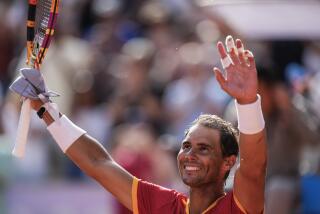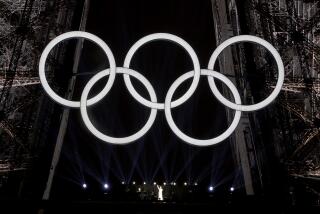Tennis gets pick-me-up in Paris
- Share via
PARIS — Long the weirdo of the men’s tennis majors, the French Open has become a veritable homecoming king. It’s the new global leader in intrigue and pertinence.
Its three brethren -- the Australian Open, Wimbledon and the U.S. Open -- have become those tournaments Roger Federer always wins, and while only a devoted prude could yawn watching Federer play tennis, only the French Open retains the peerless mystery of an ongoing Federer climb.
As it begins anew on Sunday at Roland Garros, it’s the only major keeping Federer from the five-man list of guys with the full four-major dinner set. It keeps him from joining only Andre Agassi in winning all four since the 1960s, the way it snubbed Stefan Edberg, Boris Becker and even the 0-for-13 Pete Sampras.
It’s the major that boasts the best rival-surface combination extant, Rafael Nadal and clay. It’s the major that may well stage the most significant match of the year if Federer and Nadal reach the final on Sunday, June 10.
And it just had a becoming makeover in Hamburg.
As Federer spent the late winter and early spring not winning four straight tournaments, an unimaginable skein unseen on Planet Earth since 2004, even the French Open seemed to forfeit prospective shine.
It seemed to lose its pulse when Federer -- who said, “I don’t know what’s wrong” -- lost in the round of 16 on clay in Rome, lent a minute of fame to his 62nd-ranked conqueror Filippo Volandri, exhibited rare grouchiness, and soon jettisoned Tony Roche, his coach for six of his 10 major titles.
That’s an unusual pothole collection for a 25-year-old Swiss normally impugned for placidity. His match record stood for the year at a measly 19-4 after 90-5 in 2006, 80-4 in 2005 and 70-5 in 2004. Trying to tweak his game on clay, he seemed to be tweaking himself out of contention on clay.
And if Federer was a runaway No. 1, then one Guillermo Canas of Argentina, who beat Federer twice within 16 days in March at Indian Wells and Miami, seemed to be No. 1/2 .
All of that, plus Nadal’s 14-0 record at Roland Garros, his 5-0 record against Federer on clay and his 81-0 record in clay matches since 2005 added up to French predictability. Nadal’s 6-2, 1-0 lead over Federer last Sunday on clay in the final at Hamburg deepened the notion.
Then Federer suddenly won 11 of the last 12 games, dealt Nadal the first 6-0 loss on clay of his 21-year life in the third set, and resuscitated the French Open, all in a swoop.
Within moments, Federer uttered such pronouncements as, “It was an incredible performance from my side,” and, “It does feel like a breakthrough,” while Nadal provided a reminder about Federer in case anyone had forgotten: “He is unbelievable.”
By Friday at a news conference at Roland Garros, Federer was saying, “I’m no longer afraid of this tournament. I’m not afraid of having to play five sets. I’m not afraid of being the favorite, and I want to win here more than ever.”
His confidence had returned “back where it was,” and the French Open had resumed life even before it had officially begun, rating peerless after years of rating peerlessly quirky.
Mostly because of how its crushed-brick clay differs drastically from the other three major surfaces, the French Open has served as the oddball of the Grand Slams. The French has seemed to hail almost from a separate sport with its litany of finalists and semifinalists who proved feckless in Melbourne, London and New York.
Gaston Gaudio, the 2004 champion, has never surpassed the fourth round of any of the other Grand Slams. The same goes for Mariano Puerta, a finalist in 2005, who hasn’t ventured beyond the third round in any other. A finalist in 2003, Martin Verkerk, played only eight majors in his life and never surpassed the third round in any except that one.
Even the renowned Brazilian Gustavo Kuerten, a three-time French champion in 1997, 2000 and 2001, never exceeded quarterfinalist in the other three. The champions from 2000 to 2004 included Kuerten, Albert Costa, Juan Carlos Ferrero and Gaudio, with only Ferrero coming close to winning any other of the others.
That doesn’t mention Felix Mantilla, Dominik Hrbaty, Fernando Meligeni, Magnus Norman or Filip Dewulf, all about as famous as your next-door neighbor and all semifinalists or better within the last 10 French Opens.
In 2005 and 2006, though, the French played closer to ATP rankings relevance with the exception of Puerta, whose finalist heyday hunkered between two major doping sanctions. Nadal beat Federer in four sets in a 2005 semifinal and in four sets in the 2006 final, in both wins losing the first set and solidifying himself as No. 1 on clay and No. 2 on earth.
After that 1-6, 6-1, 6-4, 7-6 (4) loss in 2006, Federer’s only loss that year in 28 grand slam matches, three-time French champion Mats Wilander suggested that Federer had lacked, well, intestinal fortitude, not using that precise terminology.
In Hamburg, then, Federer cited his turn as aggressor. In Paris, he’ll start against 71st-ranked American Michael Russell, and Nadal embarks against 58th-ranked Juan Martin Del Porto of Argentina. Federer will star in the intrigue of possible breakthrough, and while everyone watches for Federer vs. Nadal, in Federer’s half of the draw lurks the 22nd-ranked Canas, named after Guillermo Vilas, the 1977 champion.
As Federer bids to become the first man since Rod Laver in 1969 to hold all four major titles at once, that could make for a curious semifinal, possibly preceding a curious final in a very curious French.
More to Read
Go beyond the scoreboard
Get the latest on L.A.'s teams in the daily Sports Report newsletter.
You may occasionally receive promotional content from the Los Angeles Times.










